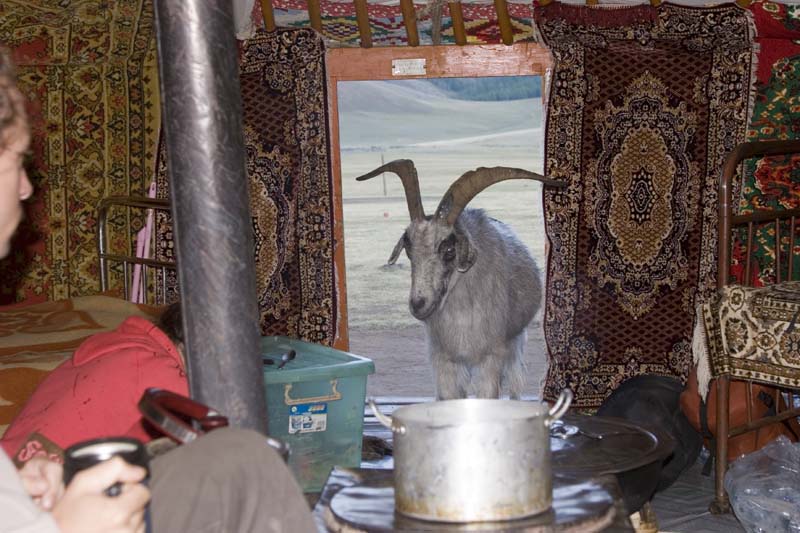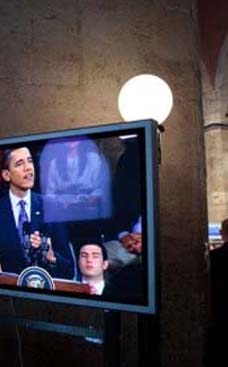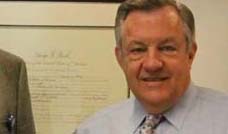
GOATS, SHEEP, COWS: These three are everywhere. Animals are free range in Mongolia so you will see them in town, in your yard, even in your house if you're not paying attention (and my "bitten lip" favorite, you might see them eating your freshly washed clothes right off the line). These three animals are the main meat eaten in the country. I've personally been working on a goat for the past three months (but, oh, what I wouldn't give for some "vegetarian" bacon). Wool from sheep is used to make the felt that keeps my ger warm in the winter. Cows are used for milk. Goat and sheep ankle bones are used for a game called shagai. Now I know I am leaving many of their uses out, but my point is they are useful, and like I said before they are everywhere, so you really have to watch your step or there's a good possibility you will place your foot into a nice, steaming pile of fuel for your fire in the winter.
Peace Corps Volunteer Brett Campbell writes: It's an animal's world here
It's an animal's world here
Thursday, November 20, 2008
Hungry Goat - This little guy tapped on our Ger everyday wanting to eat our biscuits. It was very tough to shut the door on him! Photo: pirateparrot Flickr Creative Commons Attribution-Noncommercial 2.0 Generic
Animals are the life blood of Mongolia. They are used for food, housing, protection, sports, and games to name a few of their many uses.
Mongolians herd sheep, goats, cows, camels and every so often you can see pigs roaming around. They raise horses and keep dogs sometimes as pets, but usually as a security system. Animals are everywhere in this country (the understatement of my journalistic career), and that's exactly what I'm going to talk about, species by species.
DOGS: Dogs are usually the first line of defense from an unruly intruder and most of them are free to roam wherever they please inside and outside of the hashaa (a hashaa is a fenced in yard that most Mongolians live in). This freedom however can lead to problems. As hard as Bob Barker worked on the issue, Mongolian's do not "have their pets spayed and neutered," so that means that female dogs go into heat and have puppies that grow up and roam around town in gangs. To fight this excess of dogs, once a year Mongolians let some of the prisoners out of prison and give them rifles (that's right, rifles) and send them out to shoot stray dogs (I mean seriously, I couldn't make that up if I tried).
Now, before I move on I will tell you a story of my experience with dogs in heat. The hashaa I live in has three female dogs (which is rare because most Mongolians either dump or kill female puppies to avoid problems), but they are great dogs and love to follow me everywhere I go. They're my little girls. It wasn't long though before one went into heat and it wasn't long after that before male dogs started coming over to the hashaa. For a while I just ignored this, I mean, what kind of trouble could my dog get into by having a male dog or two over to the hashaa? Well I learned my lesson. Soon more and more dogs started coming over and it all culminated one night with me waking up to no less than 20 male dogs outside of my ger fighting over who would get my dog and me throwing rocks trying to get them to disperse.
Now I would love to have kids someday, but is this what it's going to be like to raise girls? Will there be boys coming over at all hours of the night calling on my daughter and getting into fights with other boys over who gets to date her (and the worst part is I won't even be able to throw rocks at them)? Right now, I think dogs are enough.
CAMELS: Mongolian camels are of the two hump variety. They are herded for meat and hides and also used to ride. There are also wild camels roaming the Gobi Desert. Now, since this section is a little low in information, I will give you some invaluable camel knowledge. It is a common misconception that camels store water in their humps. Did you know that actually camels keep water in pouches in their stomachs, and that their humps are fat reserves that deflate and go flaccid when the fat is used up? I'm sure most 5th graders did.
PIGS: Pigs are a minority in Mongolia and so are their products. The only place pork exists is in a type of summer sausage that Mongolian companies make. Other than that, pigs live a pretty privileged life in a country where goats and sheep live to tantalize the taste buds (too bad). And for you vegetarians out there, Mongolians do not consider pork "meat" so be careful when ordering anything "meatless."
GOATS, SHEEP, COWS: These three are everywhere. Animals are free range in Mongolia so you will see them in town, in your yard, even in your house if you're not paying attention (and my "bitten lip" favorite, you might see them eating your freshly washed clothes right off the line). These three animals are the main meat eaten in the country. I've personally been working on a goat for the past three months (but, oh, what I wouldn't give for some "vegetarian" bacon).
Wool from sheep is used to make the felt that keeps my ger warm in the winter. Cows are used for milk. Goat and sheep ankle bones are used for a game called shagai. Now I know I am leaving many of their uses out, but my point is they are useful, and like I said before they are everywhere, so you really have to watch your step or there's a good possibility you will place your foot into a nice, steaming pile of fuel for your fire in the winter.
HORSES: Horses are mainly used as a work animal. They are ridden by herders and sometimes used as transportation. Also, as I mentioned in a previous article, they are very important in horse racing during the Nadaam festivities of the summer. For you horse lovers out there, I'm sorry to do this to you, but, horse is also eaten in Mongolia, and it is rather tasty. That however is the extent of the life of a horse. Oh yeah, I guess I almost forgot, they are used for one more thing. There's that tart milk that horses have such an integral part in making; airag (fermented horse's milk).
There are under 3 million people living in a country that when placed on a map of the United States would stretch from Denver to New York. At the same time, there are around 25 million animals living here, and that's only the herded ones. So it's easy to say that "animals are Mongolia."
Before I go, there is one last issue I would like to address. As you have probably noticed, in Mongolia there is a serious problem of excluding certain animals from daily life. I do not condone this behavior and I will work to educate the Mongolians of their misguided ways and with some hard work and patience, one day pigs will be eaten on the same plate as cows and sheep and goats, and when that day comes, nobody will be happier than me.
EDITOR'S NOTE:
For those Chronicle Times readers interested in writing to Brett Campbell - "Our Man in Mongolia" - his proper address is listed below.
A Cherokee Washington High and Iowa State university graduate, Campbell is serving a two-year stint with the American Peace Corps, teaching English in Mongolia.
He has agreed to periodically submit articles to the Chronicle Times telling of his experiences while serving in Mongolia.
His address is:
Mongolia (via China)
Dundgovi Aimag
Gurvansaikhan Soum
9-Year Secondary School
English Teacher Brett Campbell











